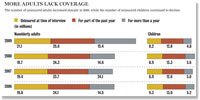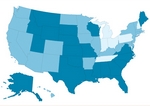government
Uninsured jumped to 46.3 million in 2009
■ Another 2.5 million U.S. adults joined the uninsured population as the ranks of the privately insured continued to decline, says a new report.
- WITH THIS STORY:
- » More adults lack coverage
Washington -- The steady increase in the number of uninsured and the decline in private coverage continued in 2009, though these trends were partially mitigated by public programs and federal coverage subsidies, a new government report concludes.
Approximately 46.3 million, or 15.4% of Americans, were uninsured at any one time in 2009, an increase of 2.5 million since 2008. That's according to estimates released June 16 by the Centers for Disease Control and Prevention's National Center for Health Statistics.
The number of uninsured might have been higher without the availability of public coverage and the COBRA subsidy in last year's stimulus package. That paid for 65% of the cost of health insurance for people who lost their jobs involuntarily, but the subsidy ended on May 31, 2010.
The uninsured population grew largely because of adults losing coverage, the survey found. The number of nonelderly adults without health insurance at any one time reached 40 million, or 21.1% in 2009 -- an increase of 2.9 million since 2008.
For children, coverage gains more than balanced out the losses, according to Robin Cohen, PhD, a CDC statistician and lead author of the report. "If there was a loss of private coverage, it was made up for with an increase in public coverage," Cohen said.
On the whole, children gained coverage by qualifying for public programs such as Medicaid and the Children's Health Insurance Program. The number of children with public coverage increased by 3.5 million in 2009, more than triple the growth of adults with public coverage.
Private coverage continued to decline across the board. The percentage of people with such plans decreased to 62.9%, down 2.5 percentage points. Similar decreases occurred in private coverage for both children and nonelderly adults.
The health coverage estimates did not contain any unexpected news, said Paul Fronstin, PhD, a senior research associate with the Employee Benefit Research Institute. Fronstin said the ending of COBRA subsidies on May 31 could push the number of uninsured people higher in 2010. Democrats in Congress have pushed for an extension of COBRA benefits, but they have been unable to attract enough support from their conservative wing or from moderate Republicans.
Fronstin said the growth in the uninsured population also was restrained by the ability of unemployed spouses to enroll in their partners' health plans. "It's one of those things that gets ignored in any discussion about health coverage," he said.
The annual CDC numbers serve as an early indicator of trends that might be highlighted in the upcoming U.S. Census Bureau uninsured estimates, typically released in late August. The CDC estimates are based on a continuous 2009 survey with a sample of roughly 88,000 people. The Census report is based on a similar-sized sample, but it uses monthly surveys conducted between February and April.













